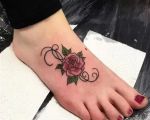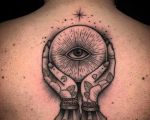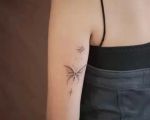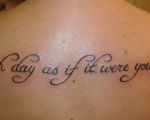The Best Ways to Communicate with Your Tattoo Artist for a Perfect Piece
May 03, 2025
The Best Ways to Communicate with Your Tattoo Artist for a Perfect Piece
Getting a tattoo is a personal and exciting experience. Whether you're planning your first tattoo or adding to your collection, one of the most important aspects of the process is communication with your tattoo artist. In my own tattoo journey, I’ve found that clear and open communication is essential to getting the design you want and ensuring a smooth tattooing process. In this article, I’ll share the best ways to communicate with your tattoo artist, offer tips based on my own experiences, and provide insight into the tattoo consultation process.
1. Do Your Research Before the Consultation
Before you even step foot in a tattoo shop, doing a bit of research can make a big difference. It's important to understand what you want and how to convey it to your artist. This doesn’t mean you need to have an exact design drawn out, but having a general idea of the style, theme, or concept you’re interested in can help guide the conversation during the consultation.
For example, I wanted a floral sleeve design, but I didn’t have the exact flowers in mind. I knew I liked the style of black and grey realism, so I showed my artist examples of tattoos I liked, along with my vision for the piece. This helped the artist understand the style I preferred and gave them the freedom to create a design that was uniquely mine. You can find inspiration through social media, tattoo websites, or in books—anything that can visually explain your idea will be useful for your artist.
2. Be Clear About Your Expectations
When communicating with your tattoo artist, it’s essential to be clear about your expectations. The more specific you can be, the better the artist will be able to execute your design. This includes explaining any elements that are crucial to the tattoo, like size, placement, and color.
For example, I once worked with an artist who was fantastic at creating delicate, fine-line tattoos. During my consultation, I made sure to express that I wanted the design to be subtle and not too bold. By communicating this clearly, my tattoo artist was able to give me the exact result I was hoping for. Don’t be afraid to speak up about what you want, and make sure the artist understands every detail before they begin drawing.
3. Trust Your Artist’s Expertise
While it’s important to communicate your ideas and preferences, it’s equally important to trust your tattoo artist’s expertise. Remember, tattoo artists are professionals with years of experience, and they know what works best for different designs and body types. If your artist suggests changes or offers recommendations, it’s worth considering their input.
For instance, when I was planning my first large tattoo, I had a specific idea in mind for the placement. However, my artist suggested a slight adjustment to avoid areas where skin movement could distort the design over time. Trusting their advice ensured that the tattoo would heal well and look great in the long run.
4. Use Visual Aids to Help Explain Your Design
Sometimes words alone aren’t enough to convey exactly what you want. That’s why bringing in reference images or sketches can be incredibly helpful. Sharing visual examples of what you have in mind can bridge any gaps in communication and help your tattoo artist understand your vision more clearly.
For example, when I was getting a landscape tattoo, I brought in a photo of a mountain scene I loved, along with some other landscape tattoos I admired. The artist then incorporated elements from those references into my design, while still making it unique to me. Images can be powerful tools in making sure you and your artist are on the same page.
5. Don’t Be Afraid to Ask Questions
During the consultation, you might have a lot of questions, and that’s okay! A tattoo is a permanent piece of art on your body, so it’s important to be fully informed before you get started. Ask questions about the artist’s experience, the tattooing process, aftercare, and anything else you may be concerned about.
I once asked an artist about the healing process for a particularly detailed piece I was getting, and the insight they gave me helped me better prepare for proper aftercare. Asking questions also shows your artist that you’re engaged and want to ensure the best possible outcome for your tattoo.
6. Be Open to Collaboration
One of the most rewarding aspects of getting a tattoo is the collaboration between you and your artist. Tattoo artists are skilled professionals who have a deep understanding of how tattoos work on the skin. By being open to their suggestions, you allow them to use their creativity and expertise to elevate your design. It’s a team effort, and the more you’re willing to collaborate, the better the tattoo will turn out.
For example, I went in with an idea for a full sleeve but was open to suggestions on how to fill in spaces. The artist suggested some abstract geometric patterns, which complemented the nature-inspired elements I had in mind. The result was a tattoo that was both cohesive and dynamic.
7. Make Sure to Discuss the Pain Level and Duration
Every tattoo experience is different, and it’s helpful to talk to your artist about the pain level and how long the session will take. This is especially important for larger pieces or areas of the body that might be more sensitive. By knowing what to expect, you can mentally prepare for the session.
For example, during my first large back piece, the artist explained that certain areas would be more painful due to the proximity to bone and nerves. Having this information helped me stay calm and focused during the tattoo, and I was able to handle the discomfort much better.
8. Conclusion: Communication is Key to a Great Tattoo Experience
Effective communication with your tattoo artist is essential to achieving the tattoo you want. Whether you’re sharing your vision, discussing design elements, or seeking advice, being clear, open, and engaged will ensure a successful collaboration. Don’t forget to trust your artist’s expertise, ask questions, and be ready to embrace their creative input. With the right communication, you’ll walk away with a tattoo that’s as beautiful as it is meaningful.







